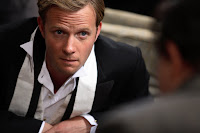 Alfred Hitchcock's 1935 thriller The 39 Steps took the action of John Buchan's World War I espionage novel and transported it forward in time to the 1930s, where the world was on the brink of yet another global war.
Alfred Hitchcock's 1935 thriller The 39 Steps took the action of John Buchan's World War I espionage novel and transported it forward in time to the 1930s, where the world was on the brink of yet another global war. As with Buchan's novel, Hitchcock's 39 Steps traced the steps taken by reluctant hero and former spy Richard Hannay as he receives a coded message from a spy who dies in his London apartment and who then finds himself enmeshed in a dangerous conspiracy that puts his life and that of everyone he comes in contact with in jeopardy.
The film, while a gripping masterpiece of intrigue and suspense, took several liberties with the underlying material and a new version of The 39 Steps--starring Spooks' Rupert Penry-Jones--goes back to the source material to craft a new adaptation that is much more in line with Buchan's original novel than Hitchcock's film.
Penry-Jones plays Hannay with the pitch-perfect combination of world-weariness and glinting adrenaline, a man who has seen the horrors of war and who is propelled from being a bored playboy onto the front lines of an invisible war occurring everywhere from the streets of London to a seemingly idyllic country loch in Scotland. Hannay is thrust into the role of being perhaps the one person able to prevent the looming catastrophe (he's given advance warning of the assassination of Archduke Franz Ferdinand, the catalyst for WWI, but is unable to stop it) and is beset by captors from all directions.
As Hannay races to avert a conflict that will forever alter the world, he is wanted for murder by British authorities after he's visited by a freelance spy (Eddie Marsan), who passes along a notebook containing a secret code before he's shot to death in Hannay's kitchen by German operatives... who are hell-bent on retrieving the code that Hannay now possesses. On his own and with nowhere to turn, Hannay sets out to evade everyone on his trail and crack the code that's been entrusted to him by leading to a small town in Scotland that's allegedly a hotbed for German secret agents.
A chance encounter with suffragette Victoria Sinclair (Rome's Lydia Leonard) leads to a partnership as the duo attempt to solve the riddle left in the dead spy's notebook and save Europe from a deadly plot that could put victory in the German's hands.
Written by Lizzie Mickery (Paradox, The State Within) and directed by James Hawes (Doctor Who), The 39 Steps does a fantastic job at capturing the heat and suspense of Buchan's novel, down to the climactic aerial assault by a bi-plane as it attempts to shoot down Hannay and remove him from the equation. (It's a sequence that Hitchcock also memorably used later in North by Northwest but it was Buchan who originated the sequence in "The 39 Steps.")
Penry-Jones offers a performance that renders Hannay both as sympathetic and deadly; he's a man who is extremely clever and defiantly self-reliant who meets his match in the headstrong Victoria Sinclair. There's a nice sense of sexual tension as well as glaring equality in their banter and battle strategies. Leonard portrays Victoria as a daughter of privilege who sees that her gilded cage of gentrified womanhood is just that: a glittering cage. And the plot gives Victoria the chance to prove that she is just as potent, cunning, and crafty as Hannay himself.
All in all, The 39 Steps is a delicious throwback to a bygone era and the sort of film that's absolutely perfect to curl up in front of and lose yourself in on a Sunday evening (or any evening, really). Offering both some well-crafted bon mots and vintage firefights, The 39 Steps is a reminder of the tenuousness of our modern world and that heroes--and villains--may emerge from the most unlikely of places.
The 39 Steps airs Sunday evening as part of PBS' Masterpiece Classic. Check your local listings for details.
Comments
Bittorrent is illegal downloading of copyrighted material. I don't support that in any way, shape, or form.
The sub was one of the biggest issues I had with the project, but didn't want to spoil it in the review. I'm also baffled about why it could only emerge from the loch for three minutes....